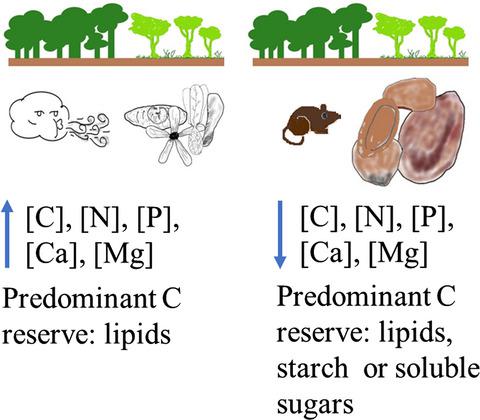当前位置:
X-MOL 学术
›
Plant Biol.
›
论文详情
Our official English website, www.x-mol.net, welcomes your
feedback! (Note: you will need to create a separate account there.)
Dispersal mode constrains allocation of carbon and mineral nutrients in seeds of forest and savanna trees.
Plant Biology ( IF 4.2 ) Pub Date : 2019-12-17 , DOI: 10.1111/plb.13075 R B de Melo 1 , C S Ferreira 1 , A Lopes 2 , C C Vinson 1 , A C Franco 1
Plant Biology ( IF 4.2 ) Pub Date : 2019-12-17 , DOI: 10.1111/plb.13075 R B de Melo 1 , C S Ferreira 1 , A Lopes 2 , C C Vinson 1 , A C Franco 1
Affiliation

|
Species vary in seed size and content of stored reserves, which can be related to dispersal strategies and type of habitat in which they are found. We compare seed carbon and nutrient reserves of anemochorous and zoochorous trees from the Cerrado of central Brazil. We measured seed dry mass, lipids, non-structural carbohydrates (starch and total soluble sugars), carbon and mineral nutrients in ten forest and 13 savanna species, each classified as having wind- or animal-dispersed seeds. We used phylogenetically independent contrasts to test for correlations among these traits. Seeds of anemochorous species were lighter, with higher concentrations of C, N, P, Ca and Mg. Lipids were the dominant carbon reserve for most anemochorous species, underpinning the importance of allocation to compact carbon reserves. Starch, lipids or soluble sugars were the major carbon reserve in zoochorous seeds. Savanna and forest species did not differ in seed mass or in total carbon reserves. However, seeds of forest species had higher concentrations of starch than seeds of savanna species. Lipid and starch negatively correlated across species, suggesting a trade-off between starch and lipids as major seed carbon reserves. Calcium was positively correlated with Mn and B, while Mg was positively correlated with C, N, P, K, S, Zn and B. Potassium, S and Cl were positively correlated, while P was positively correlated with Mg and Zn. Dispersal mode rather than vegetation type constrained seed mass and seed storage allocation patterns in forest and savanna trees. We provide evidence that similar mechanisms are involved in seed storage of carbon and mineral nutrients across species.
中文翻译:

分散模式限制了森林和稀树草原种子中碳和矿质营养素的分配。
物种的种子大小和储存储备的含量各不相同,这可能与它们的分布策略和栖息地类型有关。我们比较了来自巴西中部塞拉多(Cerrado)的软毛和软毛树的种子碳和养分储量。我们测量了10种森林和13种热带稀树草原物种的种子干质量,脂质,非结构性碳水化合物(淀粉和总可溶性糖),碳和矿物质营养素,每种物种均具有风或动物分散的种子。我们使用系统发生学上独立的对比来测试这些特征之间的相关性。绒毛动物的种子较轻,C,N,P,Ca和Mg的浓度较高。脂类是大多数无绒毛种类的主要碳储量,从而强调了分配给紧凑型碳储量的重要性。淀粉,脂质或可溶性糖是食虫种子中的主要碳储备。稀树草原和森林物种的种子质量或总碳储量没有差异。但是,森林物种的种子中淀粉的浓度高于热带稀树草原的种子。脂质和淀粉在各个物种之间呈负相关,这表明淀粉和脂质之间的权衡是主要的种子碳储量。钙与锰和硼呈正相关,而镁与碳,氮,磷,钾,硫,锌和硼呈正相关。钾,硫和氯呈正相关,而磷与镁和锌呈正相关。分散模式而不是植被类型限制了森林和热带稀树草原的种子质量和种子存储分配模式。我们提供的证据表明,类似的机制参与了跨物种碳和矿物质营养素的种子存储。
更新日期:2019-12-17
中文翻译:

分散模式限制了森林和稀树草原种子中碳和矿质营养素的分配。
物种的种子大小和储存储备的含量各不相同,这可能与它们的分布策略和栖息地类型有关。我们比较了来自巴西中部塞拉多(Cerrado)的软毛和软毛树的种子碳和养分储量。我们测量了10种森林和13种热带稀树草原物种的种子干质量,脂质,非结构性碳水化合物(淀粉和总可溶性糖),碳和矿物质营养素,每种物种均具有风或动物分散的种子。我们使用系统发生学上独立的对比来测试这些特征之间的相关性。绒毛动物的种子较轻,C,N,P,Ca和Mg的浓度较高。脂类是大多数无绒毛种类的主要碳储量,从而强调了分配给紧凑型碳储量的重要性。淀粉,脂质或可溶性糖是食虫种子中的主要碳储备。稀树草原和森林物种的种子质量或总碳储量没有差异。但是,森林物种的种子中淀粉的浓度高于热带稀树草原的种子。脂质和淀粉在各个物种之间呈负相关,这表明淀粉和脂质之间的权衡是主要的种子碳储量。钙与锰和硼呈正相关,而镁与碳,氮,磷,钾,硫,锌和硼呈正相关。钾,硫和氯呈正相关,而磷与镁和锌呈正相关。分散模式而不是植被类型限制了森林和热带稀树草原的种子质量和种子存储分配模式。我们提供的证据表明,类似的机制参与了跨物种碳和矿物质营养素的种子存储。











































 京公网安备 11010802027423号
京公网安备 11010802027423号